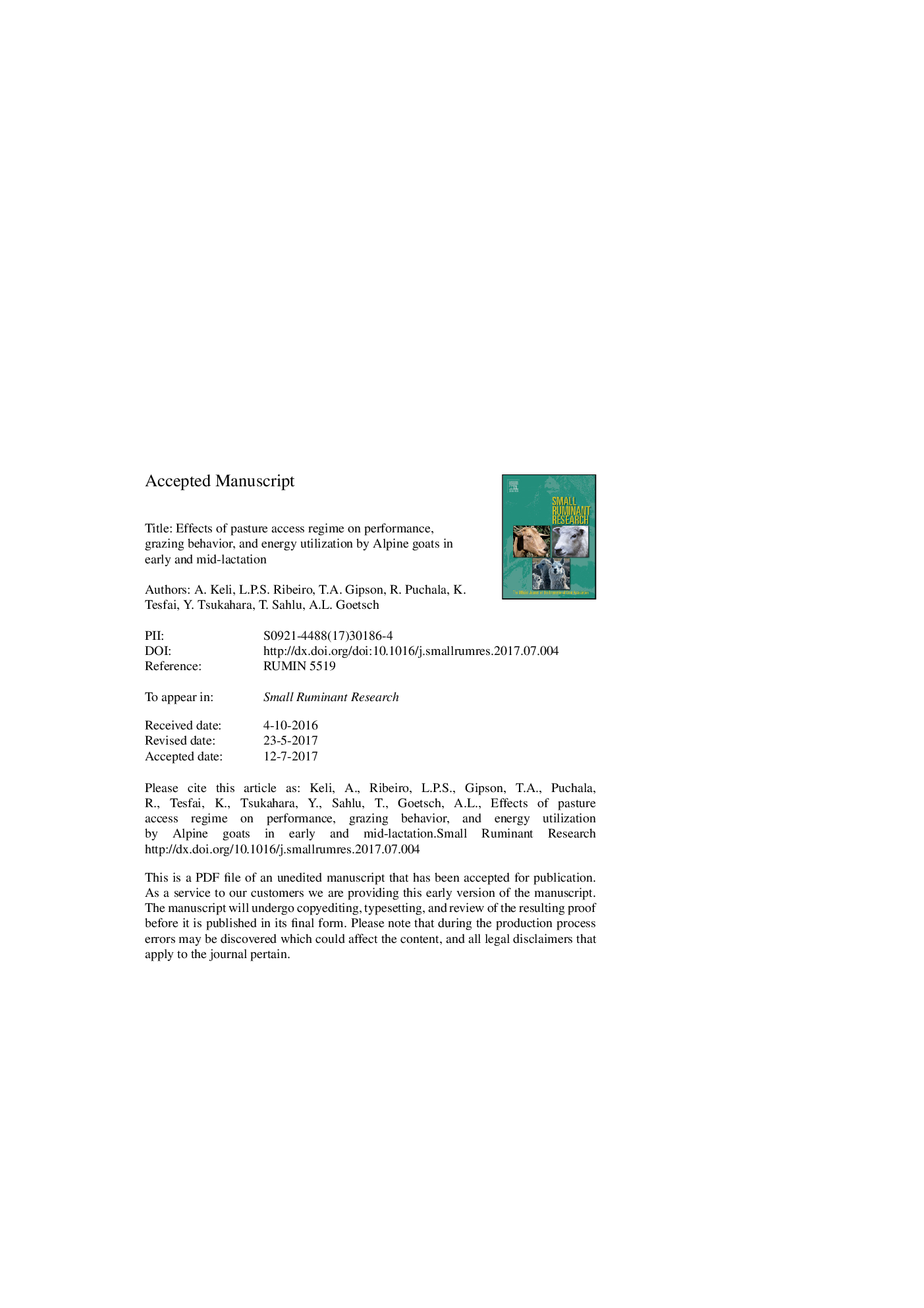| کد مقاله | کد نشریه | سال انتشار | مقاله انگلیسی | نسخه تمام متن |
|---|---|---|---|---|
| 5544213 | 1554338 | 2017 | 48 صفحه PDF | دانلود رایگان |
عنوان انگلیسی مقاله ISI
Effects of pasture access regime on performance, grazing behavior, and energy utilization by Alpine goats in early and mid-lactation
ترجمه فارسی عنوان
تأثیر رژیم دسترسی به چراگاه بر عملکرد، رفتار چرا و استفاده از انرژی توسط بز های آلپ در اوایل و نیمه شیرده
دانلود مقاله + سفارش ترجمه
دانلود مقاله ISI انگلیسی
رایگان برای ایرانیان
کلمات کلیدی
بز بزنی، انرژی، گاو نر
موضوعات مرتبط
علوم زیستی و بیوفناوری
علوم کشاورزی و بیولوژیک
علوم دامی و جانورشناسی
چکیده انگلیسی
Twenty-eight Alpine goats were used to evaluate the effects of different pasture access regimes on lactation performance, grazing behavior, and energy utilization in a 16-wk experiment with four 4-wk periods beginning at 26 ± 2.5 days in milk. Treatments were access to grass and (or) legume pasture continually other than during milking in the morning and afternoon (CG); from the time leaf surfaces were dry (measured by leaf wetness sensors) until afternoon milking and thereafter to sunset (ND-D); from the time leaf surfaces were dry until afternoon milking (ND-M); and between morning and afternoon milking (SET). The CG, ND-M, and SET goats were supplemented with approximately 1.5% body weight (BW; dry matter basis) of concentrate immediately following the afternoon milking and ND-D goats were supplemented at sunset. Organic matter digestibility, average daily gain, fecal egg count, and FAMACHA© score were not affected by treatment (P > 0.05). Milk concentrations of protein, fat, and lactose and milk energy yield (5.41, 5.06, 5.34, and 5.55 MJ/day for CG, ND-D, ND-M, and SET, respectively; SEM = 0.340) were similar among treatments (P > 0.05). Treatment affected (P < 0.05) time spent grazing (7.43, 6.93, 5.86, and 6.18 h for CG, ND-D, ND-M, and SET, respectively; SEM = 0.351). Intake of metabolizable energy (ME) was similar among treatments (P > 0.05; 1111, 1010, 1043, and 874 kJ/kg BW0.75; SEM = 89.1), daily heat energy was greatest among treatments for CG (P < 0.05) (745, 684, 631, and 667 kJ/kg BW0.75; SEM = 17.9), and milk energy as a percentage of ME intake was greatest (P < 0.05) for SET (30.2, 28.3, 27.9, and 36.3% for CG, ND-D, ND-M, and SET, respectively; SEM = 1.52). In conclusion, there appeared potential to improve efficiency of milk production by pasture access between morning and afternoon milking compared with continuous grazing and there were no clear benefits from delaying pasture access until leaf surfaces were dry.
ناشر
Database: Elsevier - ScienceDirect (ساینس دایرکت)
Journal: Small Ruminant Research - Volume 154, September 2017, Pages 58-69
Journal: Small Ruminant Research - Volume 154, September 2017, Pages 58-69
نویسندگان
A. Keli, L.P.S. Ribeiro, T.A. Gipson, R. Puchala, K. Tesfai, Y. Tsukahara, T. Sahlu, A.L. Goetsch,
